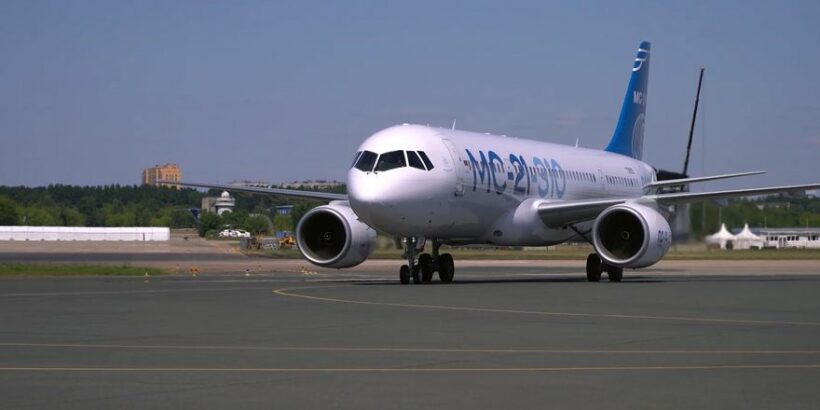In March, Rosaviation issued approval to ODK-Aviatiadvigatel JSC of the main change in the standard design of the PD-14 engine, which consists in the use of new blanks for manufacturing the main parts of the high pressure compressor and the high pressure turbine.
In the PD-14 engine design, an eight-stage high-pressure compressor with a pressure boosting degree of 17 and titanium alloy blisks on the 1st, 2nd, 5th stages and disks of the 6th, 7th, 8th stages made of nickel granule alloy were implemented. Also, a two-stage high-pressure turbine with high-efficiency cooling system, working and nozzle blades made of monocrystalline alloys, second-generation ceramic thermal protection coating, nickel alloy discs and active clearance control were developed.
* * *
This June the airframe hangar of the SSJ100 aircraft maintenance station will be put into operation at Sheremetyevo Airport. It is the largest airframe building in Russia, the width of the span of 55 meters will allow using it for the MC-21 aircraft maintenance. In the future a similar hangar is planned to be built at Koltsovo Airport. By the end of 2026 a 47 thousand sq m hangar complex will be put into operation for servicing and repairing the MC-21 and SSJ100.
* * *
On March 2, 2023 it became known that Belarus is studying the possibility of buying aircraft for its civil aviation in Russia.
According to Alexei Avramenko, Minister of Transport and Communications of the Republic of Belarus, work is underway to determine the possibility of supplying Russian aircraft to Belarus. “They are actively working on Sukhoi Superjet New and MC-21. But we will get to a more specific result when the MC-21 aircraft actually appears. There are certain preliminary agreements, we are working on this issue,” he said.
We can add that Belarus has very little choice of aircraft to replace foreign aircraft in the future. And the transition to Russian regional and long-haul aircraft looks natural and necessary.
* * *
The Omsk engineering company Polikon has developed a machine to produce tires for the MC-21 aircraft, which will replace imported GoodYear tires.
“Today we state that we have completed a big project, the development, manufacturing and testing of a machine to assemble the second stage of the aircraft tire for the MC-21 aircraft. We, by implementing this project, participate in the program of import substitution, replacement of imported aviation tires for MC-21 aircraft with domestic radial tires,” the company said.
Barnaul’s YashZ Avia plant plans to produce a pilot batch of aviation tires for the MC-21 in May. “We have a very serious task: in a very short time, during May, to produce the first pilot batches of both nose and main tires. Now the machines for their production are being handed over. Without waiting for the equipment to arrive, we are preparing the sites in order to install and hook it up right away,” said Boris Shalagin, the plant’s managing director.
* * *
On March 29 Russia Airlines announced the transition to domestic software of electronic flight board (EFB). Given that the carrier will be the first to start operating the MC-21 in two years, we asked our source at the Yakovlev Design Bureau’s Research and Development Institute in Zhukovsky what version of flight documents is used on the MC-21 aircraft, including the aircraft with the tail number 73054.
“At our EFB it was domestic right away. We didn’t have paper carriers initially,” the source explained. According to him, the MC-21 aircraft is offered to the customer in two variants: with a built-in EFB and with a slot for a tablet as, for example, the instrument board on the 73056 aircraft is made.
“The choice of software is left to the customer. The 73054 originally had a built-in EFB with domestic software,” our interlocutor added.
* * *
On March 16, after a two-month break due to the replacement of the PD-14 engines, the 73055 prototype made its first flight. Engine replacement was required by the specialists of ODK-Perm Motors to check the state of the power plant after two years of operation.

The flight profile graphs received from the FR24 service show the power plant check modes at different altitudes and speeds. The aircraft will now be partially assembled with domestic components and will resume flying under the certification program at a later date.
According to Vasily Sevastyanov, a test pilot of the A.S. Yakovlev design bureau, tests of the PD-14 in cold, heat and high altitude are yet to be conducted to expand its operational limitations.

In March, aircraft 73053 flew intensively, making 15 flights. Thus, for example, on 23 March the aircraft performed a flight to evaluate the operation of the main computers (Flight management system , FMS) – the main and backup ones – after updating the software. The flight track is shown on the image from the FR24 service.
According to a source at the Yakovlev Design Bureau, in March, the algorithms of the automatic control system (ACS) were tested during flights along air routes and maneuvering in the airfield area. In addition, flights were performed to expand operating conditions and to optimize the settings of the aircraft systems and the PD-14 engine.
Aircraft 73051 also took to the skies. This machine, equipped with PD-14 engines, made three flights.
A total of 19 flights with a total duration of 46 hours and 37 minutes were performed in March. The following aircraft remained on the ground: aircraft 73054 – of typical design, intended for retraining of pilots of Rossiya Airlines and aircraft 73056 – also of typical design, which is used for ground testing of new domestic equipment and testing of emergency escape of the aircraft.

